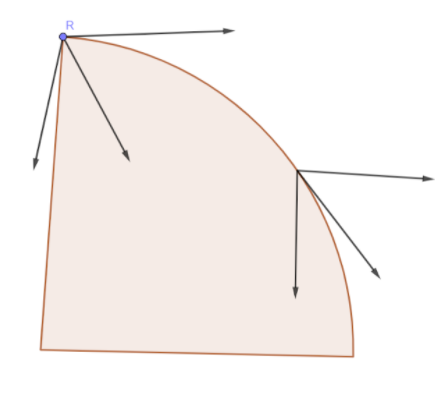
A body is projected at a speed of $30\,m\,{s^{ - 1}}$from a very high tower. What will be the speed after $4\,s$ ?
A. $20\,m\,{s^{ - 1}}$
B. $50\,m\,{s^{ - 1}}$
C. $54\,m\,{s^{ - 1}}$
D. $70\,m\,{s^{ - 1}}$
Answer
487.5k+ views
Hint: This is an example of horizontal projectile motion. At every point throughout the motion the velocity vector can be represented with its x and y components. Since the acceleration is acting only downwards, the x component of the velocity should not change. In the y direction, we can simply apply the speed equation to get the velocity along the y axis.
The speed equations are
$v = u + at$
$s = ut + \dfrac{1}{2}a{t^2}$
$2as = {v^2} - {u^2}$
Where u is the initial velocity, v is the final velocity, s is the distance covered, t is the time taken and a is the acceleration.
Also, the final velocity is the resultant of the two components. Since the components here are along the x axis and the y axis, the angle between them is \[{90^0}\] . And so, the resultant can be calculated as
\[v = \sqrt {v_x^2 + v_y^2} \]
Complete step by step solution:
The situation can be visualised as

Let the velocity after 4 s be v and its x and y components be ${v_x}$ and ${v_y}$ respectively.
Since there is no acceleration acting in the horizontal direction the velocity in x direction remains same as the initial velocity.
So, ${v_x} = 30\,m\,{s^{ - 1}}$
Now in y direction,
$u = 0$ , $t = 4s$ ,$a = + g$ and ${v_y} = ?$
Using the speed equation $v = u + at$
Substituting the values, we get
${v_y} = 0 + 4g$
$ \Rightarrow {v_y} = 4 \times 10$
$ \Rightarrow {v_y} = 40\,m\,{s^{ - 1}}$
Now we have found the components of the velocity in both x and y directions.
The resultant of these components is the actual answer.
Since the angle between both the components is \[{90^0}\] ,
The resultant is given by\[v = \sqrt {v_x^2 + v_y^2} \]
Substituting the values,
\[v = \sqrt {{{30}^2} + {{40}^2}} \]
$ \Rightarrow v = \sqrt {1600 + 900} $
Further solving this,
$ \Rightarrow v = \sqrt {2500} $
And hence $v = 50\,m\,{s^{ - 1}}$
Hence option B is correct.
Note: Always keep a note of the direction of the acceleration. If it is the same as the motion of the object then we take + sign for acceleration. Likewise, if the direction is opposite then we take a – sign. This is also known as retardation. We use the value of g as $10\,m\,{s^{ - 2}}$ to simplify our calculations.
The speed equations are
$v = u + at$
$s = ut + \dfrac{1}{2}a{t^2}$
$2as = {v^2} - {u^2}$
Where u is the initial velocity, v is the final velocity, s is the distance covered, t is the time taken and a is the acceleration.
Also, the final velocity is the resultant of the two components. Since the components here are along the x axis and the y axis, the angle between them is \[{90^0}\] . And so, the resultant can be calculated as
\[v = \sqrt {v_x^2 + v_y^2} \]
Complete step by step solution:
The situation can be visualised as

Let the velocity after 4 s be v and its x and y components be ${v_x}$ and ${v_y}$ respectively.
Since there is no acceleration acting in the horizontal direction the velocity in x direction remains same as the initial velocity.
So, ${v_x} = 30\,m\,{s^{ - 1}}$
Now in y direction,
$u = 0$ , $t = 4s$ ,$a = + g$ and ${v_y} = ?$
Using the speed equation $v = u + at$
Substituting the values, we get
${v_y} = 0 + 4g$
$ \Rightarrow {v_y} = 4 \times 10$
$ \Rightarrow {v_y} = 40\,m\,{s^{ - 1}}$
Now we have found the components of the velocity in both x and y directions.
The resultant of these components is the actual answer.
Since the angle between both the components is \[{90^0}\] ,
The resultant is given by\[v = \sqrt {v_x^2 + v_y^2} \]
Substituting the values,
\[v = \sqrt {{{30}^2} + {{40}^2}} \]
$ \Rightarrow v = \sqrt {1600 + 900} $
Further solving this,
$ \Rightarrow v = \sqrt {2500} $
And hence $v = 50\,m\,{s^{ - 1}}$
Hence option B is correct.
Note: Always keep a note of the direction of the acceleration. If it is the same as the motion of the object then we take + sign for acceleration. Likewise, if the direction is opposite then we take a – sign. This is also known as retardation. We use the value of g as $10\,m\,{s^{ - 2}}$ to simplify our calculations.
Recently Updated Pages
Master Class 11 Business Studies: Engaging Questions & Answers for Success

Master Class 11 Computer Science: Engaging Questions & Answers for Success

Master Class 11 Maths: Engaging Questions & Answers for Success

Master Class 11 Chemistry: Engaging Questions & Answers for Success

Master Class 11 Economics: Engaging Questions & Answers for Success

Master Class 11 Accountancy: Engaging Questions & Answers for Success

Trending doubts
What is meant by exothermic and endothermic reactions class 11 chemistry CBSE

10 examples of friction in our daily life

One Metric ton is equal to kg A 10000 B 1000 C 100 class 11 physics CBSE

1 Quintal is equal to a 110 kg b 10 kg c 100kg d 1000 class 11 physics CBSE

Difference Between Prokaryotic Cells and Eukaryotic Cells

What are Quantum numbers Explain the quantum number class 11 chemistry CBSE




